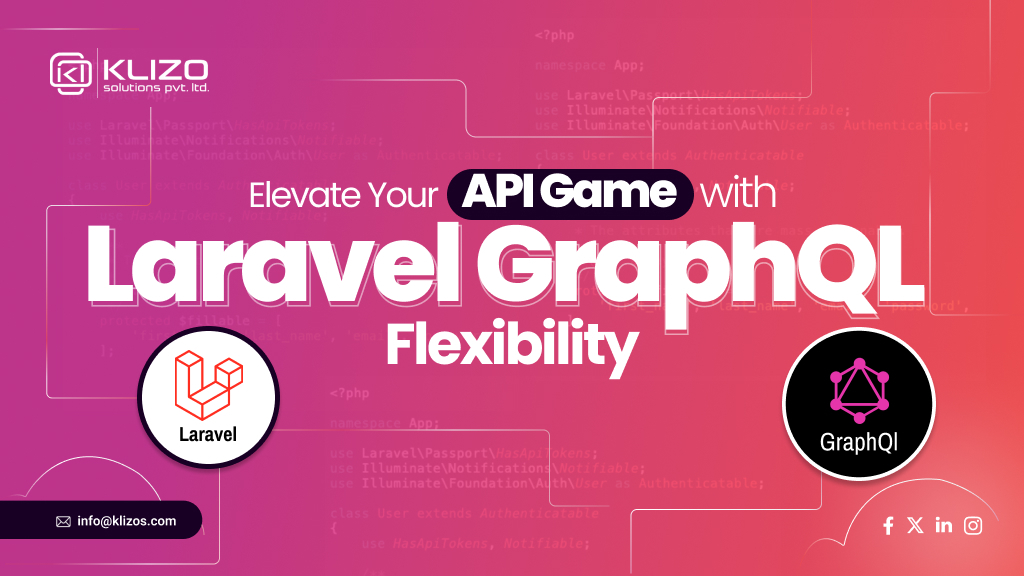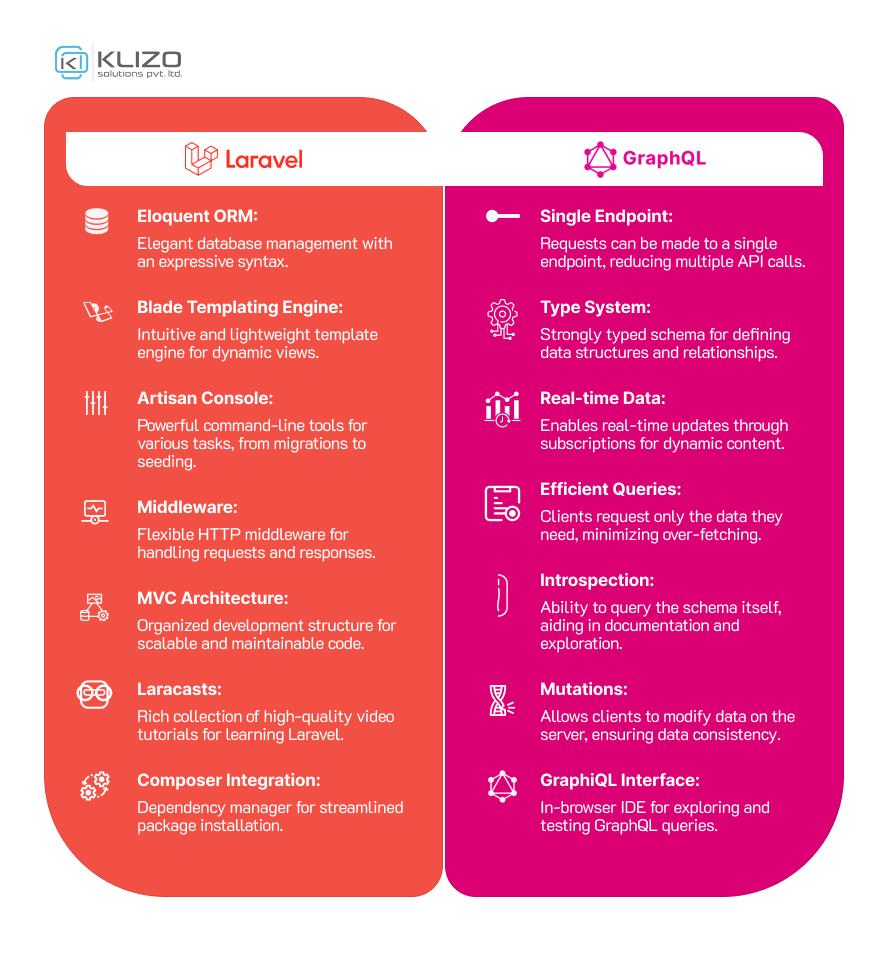


In today’s lightning-fast and ever-evolving digital landscape, APIs (Application Programming Interfaces) are the linchpin that seamlessly connects diverse applications and services. Crafting APIs isn’t merely about functionality; it’s about optimizing for a silky-smooth user journey.
And the combination Laravel GraphQL has captured the hearts of developers for robust, flexible, and more redefining API development.
While GraphQL is the data-query powerhouse ensuring sleek data retrieval and manipulation, Laravel serves as the revered PHP framework, standing tall in the realm of API development and simplifying web app creation.
While our super talented team of developers are leveraging this awesome combination already, if you want to discover the perks Laravel GraphQL bestows upon the world of app development, flexible APIs to be more specific, then this article is for you!
Laravel is a popular (around 731,453 live websites are using it) PHP web framework providing a set of tools and features to build web applications. It follows the MVC (Model-View-Controller) architecture, which separates the application logic from the presentation layer.
GraphQL is a modern and versatile query language for APIs that allows clients to specify exactly what data they need and how they want it. It also facilitates nested and relational queries, empowering clients to retrieve data from various sources within a single request.

GraphQL Laravel are two technologies that can help developers create flexible data-driven APIs that can handle complex data queries and mutations. Let’s get into that next.
Combining php Laravel GraphQL frameworks for API development is a powerful synergy that brings a host of advantages, revolutionizing how developers design and interact with APIs. They help you take your API game to the next level.
The amalgamation of GraphQL and Laravel in API development represents a leap forward in efficiency, flexibility, and developer satisfaction. Let’s take a detailed look!
The fusion of GraphQL and Laravel represents a revolutionary leap in the efficiency of data retrieval.
GraphQL’s distinctive feature allows clients to specify the exact data they need, mitigating the common issues of over-fetching and under-fetching data that are often associated with traditional RESTful APIs.
Consider a mobile app needing only usernames and profile pictures. Now with GraphQL, the query can be customized to fetch solely these fields, ensuring compact and efficient data transfers, which enhances performance and reduces the load of unnecessary data transfers for a more streamlined system
Another one of the remarkable advantages of Laravel GraphQL is the unprecedented flexibility it provides in crafting data queries.
Unlike rigid REST APIs, GraphQL enables clients to request precisely the data structures they need.
This adaptability allows developers to create complex queries tailored to the specific requirements of each client.
For example, a content management system might have different data needs for a newsfeed versus a user profile, and GraphQL empowers developers to accommodate these diverse demands seamlessly.
GraphQL streamlines API management by consolidating multiple resource requests into a single endpoint.
It contrasts with RESTful APIs that often require distinct endpoints for various resources. This integration simplifies the structure of the API, streamlining its management and decreasing the volume of network requests required to retrieve associated resources.
For instance, a single GraphQL query could retrieve information about a user along with their associated comments and posts, simplifying the development process and improving API performance.
Laravel GraphQL’s support for subscriptions adds a real-time dimension to API development.
This feature is particularly valuable for applications that demand instant data synchronization, such as live chat, notifications, or dynamic content updates.
Take a chat application developed using Laravel and integrating GraphQL subscriptions for example that has the ability to promptly deliver new messages to users. This enhances user experience by fostering a more interactive and engaging platform.
The Schema Definition Language (SDL) in GraphQL serves as a robust instrument for outlining the API’s structure, providing a potent means to define its architecture. This clear and concise language acts as a contract between frontend and backend teams, facilitating better collaboration.
For example, defining a “User” type with specific fields in SDL ensures consistency between what the client expects and what the server provides, fostering a shared understanding between development teams and minimizing potential miscommunications.
The seamless integration of GraphQL with Laravel’s Eloquent ORM enhances the development experience by providing a robust database interaction layer.
Eloquent, known for its expressive syntax, allows developers to work directly with database models in GraphQL queries and mutations.
For instance, fetching a user’s data from the database in response to a GraphQL query becomes an intuitive process, aligning with the principles of both Laravel and GraphQL and reducing the need for complex database-related boilerplate code.
GraphQL’s focus on efficiency extends to the reduction of unnecessary overhead and boilerplate code.
Clients request only the specific data they need, and servers respond with precisely that data. This streamlined approach simplifies the development process, leading to more concise and manageable codebases.
For instance, a GraphQL query fetching user information doesn’t involve retrieving extraneous data fields, resulting in cleaner and more readable code on both the server and client sides.
Combining Laravel GraphQL improves the overall developer experience by providing user-friendly tools like Artisan commands for setup and management.
Laravel’s elegant syntax and developer-friendly features create an environment that allows developers to focus on building features rather than navigating complexities.
For example, when you use Artisan commands to set up GraphQL endpoints, the process becomes intuitive, reducing the learning curve and contributing to a more enjoyable and efficient development workflow.
So you see, Laravel and GraphQL together can revolutionize how you craft APIs. Building an API with the Laravel GraphQL magic touch is a paradigm shift from the traditional REST API architecture.
As we conclude this enlightening voyage of exploring the vast potential of this dynamic duo, the question remains: How will you harness the transformative capabilities of Laravel and GraphQL for your projects?
The answer is with Klizo Solutions as we stand ready to guide you through it.
As a reputed name in the development industry, our commitment to staying at the forefront of technology, employing the latest methods, and boasting a team of Laravel GraphQL experts makes us your ideal app development partner.
After all, Klizo is not just a development choice but your gateway to a future where your applications thrive with seamless, cutting-edge technology. Together, let’s turn your API dreams into a reality, embracing the flexibility and innovation that Laravel GraphQL brings to the table!
Connect with us today, and let the journey to API mastery begin!
Previous article
The Future of Property Viewing: 3D Virtual Tours Real Estate
Joey Ricard
Klizo Solutions was founded by Joseph Ricard, a serial entrepreneur from America who has spent over ten years working in India, developing innovative tech solutions, building good teams, and admirable processes. And today, he has a team of over 50 super-talented people with him and various high-level technologies developed in multiple frameworks to his credit.

Subscribe to our newsletter to get the latest tech updates.